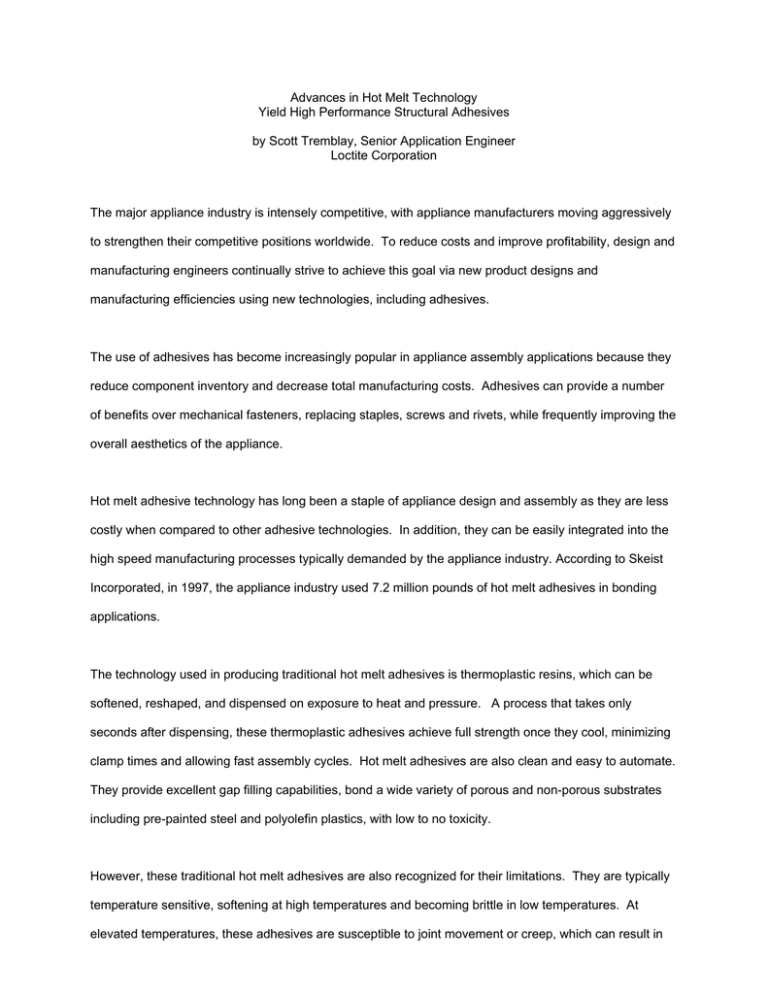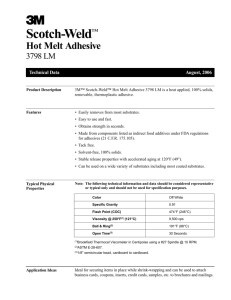Open
advertisement

Advances in Hot Melt Technology Yield High Performance Structural Adhesives by Scott Tremblay, Senior Application Engineer Loctite Corporation The major appliance industry is intensely competitive, with appliance manufacturers moving aggressively to strengthen their competitive positions worldwide. To reduce costs and improve profitability, design and manufacturing engineers continually strive to achieve this goal via new product designs and manufacturing efficiencies using new technologies, including adhesives. The use of adhesives has become increasingly popular in appliance assembly applications because they reduce component inventory and decrease total manufacturing costs. Adhesives can provide a number of benefits over mechanical fasteners, replacing staples, screws and rivets, while frequently improving the overall aesthetics of the appliance. Hot melt adhesive technology has long been a staple of appliance design and assembly as they are less costly when compared to other adhesive technologies. In addition, they can be easily integrated into the high speed manufacturing processes typically demanded by the appliance industry. According to Skeist Incorporated, in 1997, the appliance industry used 7.2 million pounds of hot melt adhesives in bonding applications. The technology used in producing traditional hot melt adhesives is thermoplastic resins, which can be softened, reshaped, and dispensed on exposure to heat and pressure. A process that takes only seconds after dispensing, these thermoplastic adhesives achieve full strength once they cool, minimizing clamp times and allowing fast assembly cycles. Hot melt adhesives are also clean and easy to automate. They provide excellent gap filling capabilities, bond a wide variety of porous and non-porous substrates including pre-painted steel and polyolefin plastics, with low to no toxicity. However, these traditional hot melt adhesives are also recognized for their limitations. They are typically temperature sensitive, softening at high temperatures and becoming brittle in low temperatures. At elevated temperatures, these adhesives are susceptible to joint movement or creep, which can result in bond failure. When applied at 375 to 450°F, traditional hot melts cannot be used on temperature sensitive substrates. Open time (the amount of time before the liquid cools into a solid) is extremely limited, minimizing the time available for part adjustment. Recent Technological Advances Several new, high performance structural hot melt adhesives have been developed over the last 5 - 10 years that meet some of the challenges associated with traditional hot melt adhesives. These new advances are designed to help manufacturers reduce costs and improve manufacturing efficiencies. Yet with the most recent advances in hot melt adhesive technology, hot melt adhesives are not fully understood or utilized by most manufacturers. Continuous improvements in the raw materials used to formulate hot melt adhesives have allowed adhesive manufacturers to engineer new high performance formulations available today. Raw materials include tackifying resins, waxes, antioxidants, plasticizers, and other fillers, which are incorporated into base hot melt resins to enhance adhesive performance. For example, natural or synthetic tackifiers are generally added to certain formulations to alter the adhesion, surface wetting, open time, polymer flexibility or tack of the adhesive. Waxes help diminish pellet blocking, reduce melt viscosity, and/or modify the tack or “green strength” of the adhesive. Antioxidants are used to prevent the resin from oxidizing and to aid in processing and storage tank stability of large volumes. Today’s high performance structural hot melts, formulated with advanced raw materials, include ethyl vinyl acetate (EVA) adhesives for general purpose bonding, polyolefin adhesives for difficult-to-bond plastics, polyamide adhesives for severe environments, and reactive urethanes for elevated temperature or high flexibility requirements. EVAs EVA hot melts are formulated with resin, tackifiers and waxes in varying proportions depending on the adhesive’s end use. For years, the majority of EVA applications have involved cardboard box sealing and packaging. Today’s advances in formulation technology now allow these adhesives to be used for more general-purpose bonding applications. This technology is currently experiencing the greatest growth in the appliance industry, with usage increasing approximately six percent per year. New EVA formulations offer short to moderate open times 40 - 60 seconds, and excellent adhesion to many substrates including paper, wood, plastics, rubbers, metals (especially steel and aluminum), and painted metals. Pressure-sensitive EVAs, which stay tacky even after cooling are a recent advancement in hot melt technology, and are becoming increasingly popular for product assembly applications. Certain adhesive manufacturers offer specialty EVA hot melts that are FDA approved for indirect food contact, allowing this adhesive to be used not only in food packaging but also in cooking and food related applications. These adhesives offer advantages for applications that require 21 CFR.175 approval or applications such as bonding insulation in refrigeration systems, positioning/tacking electrical wire harnesses, and other general purpose assemblies such as bonding tags and labels to appliances. Polyamide Hot Melts Polyamides are excellent adhesives and molding polymers for severe environments, including materials exposed to solvents such as gas or oil, or applications needing temperature resistance up to 160°C. Offering superior thermal stability, good chemical resistance and strength, these tough polymers are excellent for electrical potting applications. Polyamide hot melts offer good adhesion to a wide range of substrates including metal, wood, vinyl, ABS, and treated polypropylene and polyethylene. Certain adhesive manufacturers offer UL-approved polyamide hot melts specifically formulated for electrical applications where reduced flammability is critical. Polyamides are ideal in such appliance applications as potting water level switches, bonding filters in air conditioners, and other general purpose bonding and potting applications that require UL 94V-0 certifications. Polyolefin Hot Melts Polyolefin hot melts are a unique combination of base resins and tackifiers. This hot melt technology provides superior adhesion to polypropylene, a good barrier against moisture and water vapor, and excellent chemical resistance against polar solvents and solutions including acids, bases, and alcohols. When compared with EVA and polyamide hot melt adhesives, polyolefins offer extended open times for positioning of parts. In the appliance industry, the use of polyolefins is expected to continue growing based on their ability to resist moisture and chemicals. These adhesives offer new solutions for appliance makers in difficult-tobond plastics applications such as bonding plastic hoses to inlets or bonding felt to dryer drums. Reactive Urethanes The newest and fastest growing category of hot melt adhesives is reactive urethanes, designed for high impact, toughened applications. Introduced in the early 1990’s, reactive urethanes are a new, hybrid chemistry. These adhesives are the only thermosetting hot melt adhesives that combine the advantages of traditional thermoplastic technology with the high performance characteristics of reactive adhesive chemistries (Figure 1). Reactive urethanes begin to polymerize as they cool, but also undergo a secondary moisture cure that causes the adhesive to crosslink, forming a new polyurethane polymer that provides higher strength and flexibility than traditional hot melts. Applied as a drop or a thin bead, high viscosity reactive urethanes set quickly, becoming structurally rigid in minutes. This rapid solidification allows the on-line manufacturing process to continue uninterrupted, while secondary moisture cure continues for up to 24 hours. Reactive urethane hot melts provide unmatched performance capabilities including excellent solvent and chemical resistance, flexibility, and bond versatility. Because they are thermoset adhesives, reactive urethane hot melts offer lower initial green strength and can be formulated to have extended open times in excess of three minutes if necessary. These extended open times allow reactive urethane hot melts to be applied using a variety of methods including roll coating, swirl coating, spraying or standard adhesive dispensing. Reactive urethanes are suitable for use on thermally sensitive substrates, as their application temperature is only 250°F, substantially lower than the 375° to 450°F application temperatures of traditional hot melts. Unique for this category of adhesive, reactive urethane adhesives are heat resistant and can be used in heat sensitive end use applications, as well as for bonding appliance housings and cabinets, bonding thermal and sound insulation panels in dishwashers and dryers, and adhering labels, nameplates, touchpads, and vinyl gaskets. Problem Solving For applications where even the newest hot melt products on the market are not appropriate -- for example, where longer open times are necessary to complete a bonding application – appliance manufacturers should work with their adhesive supplier to develop custom-engineered hot melt adhesives that provide the required performance characteristics. Using unique combinations of raw materials, adhesive manufacturers can change the adhesive’s composition to increase or decrease open time, viscosity, adhesion, flexibility, and tack. Appliance manufacturers experiencing performance problems with their hot melt adhesives should also investigate the compatibility of their hot melt formulation and their dispense system. Hot melt adhesives, commonly available as pellets, chips, sticks , pillows and blocks, are heated and dispensed via manual, pneumatic or automated equipment. Proper equipment and set-up can solve many hot melt performance and dispense issues including stringing, charring and premature solidification. Figure 2 addresses a variety of common hot melt application and performance problems, and their probable causes and solutions. Figure 2 PROBLEM Adhesive on one substrate only. Adhesive surface glossy. POSSIBLE CAUSE Inadequate wet-out of secondary surface. Not enough open time. Adhesive on both substrates with leggy strings. Joint movement during adhesive solidification. Adhesive mostly on one substrate. Condition of the substrate surface or type of substrate. Insufficient adhesive in bond Absorption of adhesive by porous SUGGESTED SOLUTIONS 1. Apply more adhesive. 2. Apply adhesive at higher temperature. 3. Preheat substrate. 4. Shorten time between adhesive application and substrate compression. 5. Try a slower setting adhesive. 1. Apply adhesive at lower temperature. 2. Increase compression time. 3. Try a faster setting adhesive. 1. Clean or prime substrate. 2. Apply adhesive at higher temperature. 3. Try another adhesive. 1. Apply adhesive at lower area. substrate. Bond opens when compression is released. Adhesive isn’t cooling fast enough. Too much adhesive. Substrate too hot. Improper adhesive. Adhesive temperature too high. Faulty heat control. Inadequate adhesive heat stability. Charring or gelling of adhesive in applicator. temperature. 2. Apply more adhesive. 3. Use higher viscosity adhesive. 1. Cool substrate and/or adhesive. 2. Decrease amount of adhesive. 1. Lower adhesive temperature. 2. Check temperature indicator with another thermometer. 3. Try a more heat stable adhesive or clean out applicator more often. ### Caption for Figure 1: Traditional thermoplastic hot melts achieve full strength once cooled. Reactive urethanes achieve green strength once cooled and obtain performance properties within 24 hours. Typical non-hot melts such as cyanoacrylates, anaerobics, epoxies, and acrylics slowly increase in strength over time.


